 BeatrixFan is an English drag queen with an unhealthy obsession with big hair. He has been a forum member for four years and has a special passion for the Duchess of Cornwall. Totally unreciprocated of course.
BeatrixFan is an English drag queen with an unhealthy obsession with big hair. He has been a forum member for four years and has a special passion for the Duchess of Cornwall. Totally unreciprocated of course.Whether you’re a devotee of the surgeon’s knife or whether you’re resigned to growing old gracefully, there’s something even more inevitable than wrinkles – death. It comes to us all, but it remains one of the world’s little quirks that despite ending up in the same waxy position as a pauper, if you’re a Prince in life so shall you depart in regal style. Royalty has adopted its own customs for seeing off its stiff Dukes and Duchesses which makes the final Tube journey on the Underground of existence as imperious as possible. Not only do the mourners have the responsibility to look dignified during the grand procession favoured by European royals, but the corpse has to behave itself both before and after. Before croaking, a tongue-in-cheek quip that can make many a dinner table roar with affectionate laughter is in order. Edward VII chose to acknowledge the results of the 4.15 at Kempton (after bidding farewell to his wife and his mistress, seated side by side at his bedside), while Madame de Pompadour applied a lashing of rouge before breathing her last. After the individual in question dies, the ceremonial begins, and it is here, my dear readers, that variety is most definitely the spice of death. In Europe, the descendants of Victoria and Christian flock in their droves like well-heeled lambs to churches. In the Far East, most exotic rituals are undertaken with ancient splendour revived. The death of the Maori queen in 2006 was an occasion for ceremony and ritual, although it involved bare-chested warriors instead of soldiers in uniform, a woven mat instead of a Royal Standard draped over the coffin, and a journey in a canoe instead of a procession through the streets on a gun carriage or a hearse.
Pharaohs
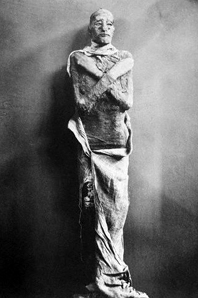 Ironically, death was the most important part of Egyptian life and something that was prepared for over many years, with the building of a Pharaoh's tomb which started the moment he became King. The rituals surrounding royal death in Ancient Egypt have given the world some of its most inspiring stories, amazing architecture, and luxurious riches. Pharaohs gave a new meaning to the word tomb, and in much the same way as the Ancient Chinese Emperors were buried, death was seen as an extension to life but they also believed that the body was somehow used as a vehicle into the next world and so not only preserved it but filled the tomb with practical items such as new clothes, jewellery, wines, chariots, shoes, weapons, furs, silks, and money. This belief was responsible for the terracotta army, a staggeringly complex multitude of clay figures cast for the tomb of the first Emperor of China, Qin Shi Huangdi. His companions included not only warriors to help him conquer new realms in the afterlife but also hundreds of bureaucrats and court officials to make his reincarnation as wealthy as his life. The Ancient Egyptians didn't believe in reincarnation, but they did believe in the importance of preserving a body, and so was born the art of mummification (impressively exemplified by Ramses III [pictured at left]). For those who are squeamish, go and pour a pink gin now.
Ironically, death was the most important part of Egyptian life and something that was prepared for over many years, with the building of a Pharaoh's tomb which started the moment he became King. The rituals surrounding royal death in Ancient Egypt have given the world some of its most inspiring stories, amazing architecture, and luxurious riches. Pharaohs gave a new meaning to the word tomb, and in much the same way as the Ancient Chinese Emperors were buried, death was seen as an extension to life but they also believed that the body was somehow used as a vehicle into the next world and so not only preserved it but filled the tomb with practical items such as new clothes, jewellery, wines, chariots, shoes, weapons, furs, silks, and money. This belief was responsible for the terracotta army, a staggeringly complex multitude of clay figures cast for the tomb of the first Emperor of China, Qin Shi Huangdi. His companions included not only warriors to help him conquer new realms in the afterlife but also hundreds of bureaucrats and court officials to make his reincarnation as wealthy as his life. The Ancient Egyptians didn't believe in reincarnation, but they did believe in the importance of preserving a body, and so was born the art of mummification (impressively exemplified by Ramses III [pictured at left]). For those who are squeamish, go and pour a pink gin now.
It was believed that the soul of a dead Pharaoh would live on in his body before being liberated by the Gods. The intense heat of Egypt generally caused bodies to decompose within a matter of hours, and so the ancients developed mummification, the art of preservation. Little did they know that their technique would mean that even today, nearly 2000 years later, mummies are still being unearthed intact. The Pharaoh would be laid on a board and the abdomen opened so that the internal organs could be removed and placed in canopic jars. These went with the Pharaoh into his tomb, and it was believed that the theft or loss of these jars preventing one entering the afterlife as one would be incomplete. Lungs, liver, intestines, and stomach were placed into special containers with the hope that they'd survive, but in all those found, the organs haven't survived. Bones in the cranium were then smashed and the brain pulped with a rod before being pulled through the nose and discarded. After cleaning, the head cavity was filled with resin and the other cavities were packed with a type of salt which removed any liquids from the body. Moisture causes decomposition, and over 40 days, the body was completely dried. Then it would be wrapped in bandages and placed in a sarcophagus, ready to be buried in the Valley of the Kings.
The famous Book of the Dead actually consisted of funeral ceremonies used by royal priests and was kept for only the highest in Egyptian society, but as time went on, the knowledge became available to all and priests learned the ceremonies diligently to ensure a swift passage into the great beyond. Tombs were considered sacred and robbery was uncommon - until modern man arrived on the scene and pillaged away until his museums were as full as they could be. Even the bodies of the Pharaohs are now subjected to CAT scans and carbon dating to determine identity and age. Some may call it Egyptology; the ancients would probably be more realistic and label it grave robbing and desecration.
Popes
Perhaps the most intense ritual surrounding the death of a monarch is seen in the Papal Monarchy, for when a Pope dies the eyes of the world turn to the Vatican as they not only prepare to select a new Pontiff but carefully and reverently send the old one off on his final journey. Luckily, the Cardinals aren't left wondering what to do, because the Apostolic Constitution spells out in clearest Latin what must be done. In the past, the death of a Pope and the subsequent funeral arrangements were pretty much unknown until they had been and gone. Nowadays, the last moments of a Pope's life are relayed breath by breath to the billions of Catholics who look to the Pope as God's representative on Earth, but the ceremony surrounding the death hasn't changed for centuries.
When the doctor declares the Pope to be medically dead, the Camerlengo of the Church (a kind of Lord Chancellor) is charged with confirming the event. He takes a small silver hammer and gently taps the Pope on the head with it three times, calling the Pope's birth name and not his regnal name. If the Pope doesn't jump up and say, "Hit me with that hammer once more and I'll bash your teeth in," he is clearly dead, and immediately the people who were with him at the time of his death move out of the Papal Apartments, which are then sealed with candle wax and yellow and white ribbon. They are unsealed by his successor. The Cardinal Vicar of the Diocese of Rome then tells the world the Pope has died and the circumstances surrounding that death. Then begins the controversial ritual of embalming.
The Pharaohs were mummified, and though there are specialist companies that will gladly perform a mummification today, embalming is the only method of preserving the dead. A small cut is made in the jugular vein and the blood of the deceased is drained and then replaced with a chemical cocktail that preserves a lifelike appearance. The body can then be worked on by morticians with special sprays and cosmetics that give the corpse the appearance of someone in a deep sleep. In some cases the embalming is performed for a short viewing, but in others the intention is to provide a Lenin-style permanent memorial. Dr Pedro Ara was an Argentinian embalmer known for his use of glycerine rather than the usual formaldehyde, and his work on former first lady Eva Peron was truly stunning. In the Catholic Church there is a slight complication with bodies remaining "incorrupt." Whenever the cause of sainthood is opened for an individual, their body is exhumed. If it has not decayed or decomposed, this is taken to be a sign of sanctity. If one has been embalmed, it is impossible to tell.
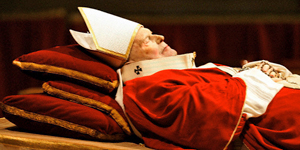
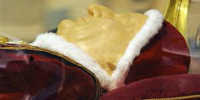 It's for this reason that the late Pope John Paul II (pictured at left) was not embalmed, though as he lay on the catafalque it was clear that decomposition was starting. Some of his predecessors were less lucky. Pope Paul VI died during a hot summer, and viewing had to be halted whilst fans were brought in to rid the Lateran Palace of the smell. Pope Pius XII's body was treated by a trainee embalmer who did such a bad job that the lying in state had to be ended early as the Pontiff's body turned black and his nose fell off. The success story is Pope John XXIII (pictured at right), whose perfectly preserved body lies proudly in his glass coffin, which is venerated to this day. Whether embalmed or not, all Popes are carried to St Peter's Basilica where they lie in state in their robes, enabling Catholics to pass by and pay their respects. The College of Cardinals declares the Novendiales, and for 9 days, part of a pre-funeral service takes place. Before the Pope is laid in his coffin, a veil of white silk is placed over his face whilst a red silk bag is placed at his feet, inside which are medals from the Pope's reign and the official notification of the burial. Once the coffin is sealed, it is placed into a coffin of lead before being placed in a third coffin of oak. Recent Popes have all chosen to be buried under marble in the grottoes under the Vatican. It is usual for the next Pope to pay his respects to his predecessor.
It's for this reason that the late Pope John Paul II (pictured at left) was not embalmed, though as he lay on the catafalque it was clear that decomposition was starting. Some of his predecessors were less lucky. Pope Paul VI died during a hot summer, and viewing had to be halted whilst fans were brought in to rid the Lateran Palace of the smell. Pope Pius XII's body was treated by a trainee embalmer who did such a bad job that the lying in state had to be ended early as the Pontiff's body turned black and his nose fell off. The success story is Pope John XXIII (pictured at right), whose perfectly preserved body lies proudly in his glass coffin, which is venerated to this day. Whether embalmed or not, all Popes are carried to St Peter's Basilica where they lie in state in their robes, enabling Catholics to pass by and pay their respects. The College of Cardinals declares the Novendiales, and for 9 days, part of a pre-funeral service takes place. Before the Pope is laid in his coffin, a veil of white silk is placed over his face whilst a red silk bag is placed at his feet, inside which are medals from the Pope's reign and the official notification of the burial. Once the coffin is sealed, it is placed into a coffin of lead before being placed in a third coffin of oak. Recent Popes have all chosen to be buried under marble in the grottoes under the Vatican. It is usual for the next Pope to pay his respects to his predecessor.
Kings and Queens
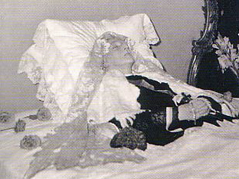 Death has many forms of course, and it would be saccharine in the very best Rodgers and Hammerstein style to suggest that Royalty always keel over politely without complaint. So drawn out was Charles II's death that he had time not only to beg his brother James to "let not poor Nelly [Nell Gwynn, one of his many mistresses] starve" but to apologise for taking so long to fall off the kingly perch. Queen Victoria was a trendsetter in her attitude to death; Victorian England was famous for rituals and traditions connected with deaths and funerals. Victoria was distraught by the death of her beloved Prince Albert; she wailed so loudly when he was pronounced dead that her screams could be heard all over Windsor. In the wedding photographs of Edward Prince of Wales and Princess Alexandra of Denmark in 1863, a pale-faced Victoria can be seen looking up adoringly at a marble bust of Prince Albert as if he had never been gone, and a portrait of the late Prince Consort was included in almost every family photograph taken after he died in 1861. Such was her love for him that memorials cropped up all over London, and when she died, she was dressed in a white dress with her wedding veil, choosing to depart as the corpse bride of a Saxe-Coburg-Gotha rather than a grand old Empress of India. Queen Amelia of Portugal (pictured above), on the other hand, chose to be buried in the blood-stained dress that she had been wearing half a century earlier on the day when her husband King Carlos I and her elder son Prince Luis Felipe were assassinated in front of her. Of course, everything we know about the departure of our favourite royals is pretty much heresay. The only British monarch to die with members of the public present was Charles I, who was executed for treason, and instead of bowing their heads silently, the onlookers rushed up to the scaffold to dip their handkerchiefs into the blood gushing from the King's headless body. However, Charles I did get a proper burial.
Death has many forms of course, and it would be saccharine in the very best Rodgers and Hammerstein style to suggest that Royalty always keel over politely without complaint. So drawn out was Charles II's death that he had time not only to beg his brother James to "let not poor Nelly [Nell Gwynn, one of his many mistresses] starve" but to apologise for taking so long to fall off the kingly perch. Queen Victoria was a trendsetter in her attitude to death; Victorian England was famous for rituals and traditions connected with deaths and funerals. Victoria was distraught by the death of her beloved Prince Albert; she wailed so loudly when he was pronounced dead that her screams could be heard all over Windsor. In the wedding photographs of Edward Prince of Wales and Princess Alexandra of Denmark in 1863, a pale-faced Victoria can be seen looking up adoringly at a marble bust of Prince Albert as if he had never been gone, and a portrait of the late Prince Consort was included in almost every family photograph taken after he died in 1861. Such was her love for him that memorials cropped up all over London, and when she died, she was dressed in a white dress with her wedding veil, choosing to depart as the corpse bride of a Saxe-Coburg-Gotha rather than a grand old Empress of India. Queen Amelia of Portugal (pictured above), on the other hand, chose to be buried in the blood-stained dress that she had been wearing half a century earlier on the day when her husband King Carlos I and her elder son Prince Luis Felipe were assassinated in front of her. Of course, everything we know about the departure of our favourite royals is pretty much heresay. The only British monarch to die with members of the public present was Charles I, who was executed for treason, and instead of bowing their heads silently, the onlookers rushed up to the scaffold to dip their handkerchiefs into the blood gushing from the King's headless body. However, Charles I did get a proper burial.
Whilst the lucky ones get to prepare for death, it’s the living who are perhaps most inconvenienced. There’s the matter of honours, hats, orders of precedence, and floral tributes, and then there’s the surreal custom of court mourning. In Britain, royals constantly travel with an appropriately sombre outfit so that if a member of the family kicks the silver-plated ice bucket, they can arrive on home turf suitably attired with a “How sad” expression. This was seen very genuinely in 1952 when Elizabeth set foot in England for the first time as Queen. Lady Pamela Hicks was with her and recalls how, noting the black Daimlers prepared to take the black-clad Royals to Buckingham Palace, the Queen remarked sadly, “Oh, they’ve sent the hearses”. She was greeted by the Prime Minister, a custom that was seen most recently when the body of Diana, Princess of Wales, was flown from France to Britain.
The death of a royal has its timeline. Once the family has said a personal farewell and the Royal Coroner has confirmed the death and issued the death certificate, the public are informed. Recently, this has taken two forms: the more traditional announcement affixed on the gates of Buckingham Palace coupled with a similar announcement to the media. Then begins the complex blend of religious and secular, ceremonial and personal events that form the entire package of regal demise.
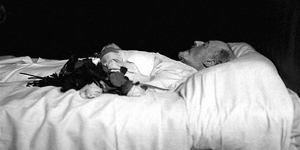 If the deceased was a reigning monarch, then his death has to be announced and the accession of the new monarch announced in which the late King or Queen is referred as to as being of blessed and glorious memory, now called to mercy. Of course, those who abdicate are not accorded this right, and the Duke of Windsor’s death was simply announced in the usual way befitting a Prince of the Realm. The first act of any monarch who comes to the throne in the natural way, therefore, is to lead the family, the court, and the nation in mourning, though most of the decisions are made by the Lord Chamberlain. The first thing that has to be decided is how long the court should mourn. When Prince Ernst, Duke of York and Albany, died in 1728, it was announced in the British Gazetteer, “The court mourning for the death of His Royal Highness the Duke of York is to be as follows, viz. The gentlemen to wear coats fully trimm’d, black buckles, black swords and plain linen; and the ladies to wear black, white or grey silks, lawn, cambric or muslin linen fring’d with black and white fans; the mourning to follow three months from tomorrow.” The two most recent deaths of senior royals, Princess Margaret and the Queen Mother, were followed by court mourning that continued until the funeral. During court mourning these days, all official engagements are cancelled, but this hasn’t always been the case. In 1910 Britain saw “Black Ascot,” when high society managed to pull itself out of grief over the death of Edward VII (pictured above) to attend the races. The dress code was formal but funereal and would inspire Cecil Beaton’s designs for the costumes seen in the Ascot scene of My Fair Lady.
If the deceased was a reigning monarch, then his death has to be announced and the accession of the new monarch announced in which the late King or Queen is referred as to as being of blessed and glorious memory, now called to mercy. Of course, those who abdicate are not accorded this right, and the Duke of Windsor’s death was simply announced in the usual way befitting a Prince of the Realm. The first act of any monarch who comes to the throne in the natural way, therefore, is to lead the family, the court, and the nation in mourning, though most of the decisions are made by the Lord Chamberlain. The first thing that has to be decided is how long the court should mourn. When Prince Ernst, Duke of York and Albany, died in 1728, it was announced in the British Gazetteer, “The court mourning for the death of His Royal Highness the Duke of York is to be as follows, viz. The gentlemen to wear coats fully trimm’d, black buckles, black swords and plain linen; and the ladies to wear black, white or grey silks, lawn, cambric or muslin linen fring’d with black and white fans; the mourning to follow three months from tomorrow.” The two most recent deaths of senior royals, Princess Margaret and the Queen Mother, were followed by court mourning that continued until the funeral. During court mourning these days, all official engagements are cancelled, but this hasn’t always been the case. In 1910 Britain saw “Black Ascot,” when high society managed to pull itself out of grief over the death of Edward VII (pictured above) to attend the races. The dress code was formal but funereal and would inspire Cecil Beaton’s designs for the costumes seen in the Ascot scene of My Fair Lady.
Deaths in royal circles can be inconveniently timed, and it has been suggested that Queen Mary’s exit was brought on a little to ensure that court mourning wouldn’t interfere with Elizabeth II's coronation plans, but there is only hearsay and supposition to support this theory. Having said that, there is no doubt that George V’s life was cut short by his doctor. Lord Dawson noted in his diary, "At about 11 o'clock it was evident that the last stage might endure for many hours, unknown to the patient but little comporting with the dignity and serenity which he so richly merited and which demanded a brief final scene. Hours of waiting just for the mechanical end when all that is really life has departed only exhausts the onlookers and keeps them so strained that they cannot avail themselves of the solace of thought, communion or prayer. I therefore decided to determine the end and injected (myself) morphia gr.3/4 and shortly afterwards cocaine gr. 1 into the distended jugular vein. Queen Mary remained calm and kindly throughout." Would Ma'am have done anything else, we wonder? This intervention meant that the King's death occurred early enough to be reported in the more prestigious morning newspapers rather than having to wait for the down-market evening papers. And there have been persistent rumours that George V's elder brother, the unpromising Duke of Clarence, did not die of entirely natural causes but was helped into the hereafter by the administration of poison as he was recovering from flu, allowing the more suitable younger brother to take his place as heir.
Assassination, Suicide, and Murder
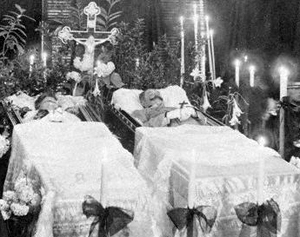 There's a lot to be admired in those royals who put themselves in line for the pearly gates when the odds are against them. For example, Archduke Franz Ferdinand of Austria and his wife Archduchess Sophie (pictured at left) were well aware of the presence of assassins in Serbia when they made their fateful (and fatal) visit to Sarajevo in 1914. Despite suffering a direct bullet to the jugular, the Archduke was heard to plead; "Sophie dear! Sophie dear! Do not die! Stay alive for our children". The pair were transported to the Governor's residence in Konak where they died, with their bodies embalmed and transported to their homeland for public display and mourning. Within a week, trenches that would see millions more follow their lead began to be dug. A similar exit would befall King Carlos I of Portugal who, whilst travelling to his Palace in Lisbon, was assassinated by a revolutionary. His son was mortally wounded, yet his wife Amelia was miraculously unharmed. She died in exile at a ripe old age. As with commoners, suicides are not exactly unknown in crowned circles. Princess Leila of Iran is the most recent case; she checked into the Leonard Hotel in London before taking a lethal concoction of cocaine and quinalbarbitone. She was just 31. At the beginning of the 20th century, Emperor Puyi's mother killed herself in China by swallowing opium. He was said to be totally unmoved by the incident since the two had been kept apart by courtiers for the majority of his formative years. Of course, these were cases of depression rather than romantic suicide pacts such as that rumoured to have been entered into by Rudolf of Austria and his mistress, Baroness Marie Vetsera. Ever so gloriously Black Dahlia, she was shot in the head by her lover before he turned the gun on himself. Their relationship had been the bane of the Hapsburg existence, and their joint suicide was ever so slightly convenient, leading to suspicions about whether the deaths really were self-inflicted.
There's a lot to be admired in those royals who put themselves in line for the pearly gates when the odds are against them. For example, Archduke Franz Ferdinand of Austria and his wife Archduchess Sophie (pictured at left) were well aware of the presence of assassins in Serbia when they made their fateful (and fatal) visit to Sarajevo in 1914. Despite suffering a direct bullet to the jugular, the Archduke was heard to plead; "Sophie dear! Sophie dear! Do not die! Stay alive for our children". The pair were transported to the Governor's residence in Konak where they died, with their bodies embalmed and transported to their homeland for public display and mourning. Within a week, trenches that would see millions more follow their lead began to be dug. A similar exit would befall King Carlos I of Portugal who, whilst travelling to his Palace in Lisbon, was assassinated by a revolutionary. His son was mortally wounded, yet his wife Amelia was miraculously unharmed. She died in exile at a ripe old age. As with commoners, suicides are not exactly unknown in crowned circles. Princess Leila of Iran is the most recent case; she checked into the Leonard Hotel in London before taking a lethal concoction of cocaine and quinalbarbitone. She was just 31. At the beginning of the 20th century, Emperor Puyi's mother killed herself in China by swallowing opium. He was said to be totally unmoved by the incident since the two had been kept apart by courtiers for the majority of his formative years. Of course, these were cases of depression rather than romantic suicide pacts such as that rumoured to have been entered into by Rudolf of Austria and his mistress, Baroness Marie Vetsera. Ever so gloriously Black Dahlia, she was shot in the head by her lover before he turned the gun on himself. Their relationship had been the bane of the Hapsburg existence, and their joint suicide was ever so slightly convenient, leading to suspicions about whether the deaths really were self-inflicted.
Royal deaths can also inspire commoner deaths. Kiten, Count Nogi, was a Japanese General who was bound by the ancient practice of junshi, requiring servants to commit hara-kiri upon the death of their master. When Emperor Meiji died in 1912, Count and Countess Nogi made preparation for their exit, putting on white kimonos and writing death poems. The two were buried in honour at Aoyama Cemetery.
Murder by one's own royal colleagues is rare, but it's something the world witnessed in 2001 when Crown Prince Dipendra of Nepal decided to massacre his family before attempting to commit suicide. Before finally dying he spent three days in a coma, during which time he was King of Nepal. His actions saw the very popular King Birendra and his Queen, Aiswarya, killed along with two of his siblings and various cousins, aunts and uncles at the Narayanhity Royal Palace. This led to the ascension of King Gyanendra, who has not only proved to be hugely unpopular and absolutist in his manner but has also seen the monarchy in Nepal done away with and has had to leave the palace while a new republican form of government is implemented.
Tributes
However rehearsed they may seem (and usually are), tributes from politicians are part and parcel of royal departure. Public tributes in the form of condolence books are a recent invention, as are tributes from the royal family, which seem to have become a must after the fury over the Queen's silence after the death of Diana, Princess of Wales, in 1997. In 2002, the Prince of Wales publicly spoke of his darling Aunt (Princess Margaret) and his magical grandmother (the Queen Mother), whilst the Queen has issued several announcements of her “deepest regret” on hearing of the passing of national figures. It’s a huge step up from the time when members of the royal family were not permitted to send flowers to the funerals of commoners (a rule the Queen broke when she sent a wreath to the funeral of Bobo McDonald) let alone attend or give a tribute on television or radio. It is usual for the leaders of all political parties to give some form of public address. This can be a sickly obsequious torch song intended to convince the electorate that though Mr X, MP, bit the head off of a baby last week, the death of a royal has really moved him into changing his infant-nibbling ways. On the other hand, it can be a matter of course and a chore that simply comes with the job. Some politicians hide their left-wing tendencies very well indeed whilst others are obviously screaming “Up the workers” inside whilst giving a stilted eulogy to someone who three weeks ago they declared to be elitist and old fashioned. Then there’s the obituary that later becomes the highlight of a premiership – I refer of course to the “People’s Princess” speech given by Tony Blair and written by spin doctor Alastair Campbell, who found the moniker used in reference to Queen Mary’s mother, Princess Mary Adelaide (fondly known by the British people as Fat Mary), to be the perfect title for Mr Blair to bestow on Diana. The speech (complete with onion-induced tears) captured the mood of the nation but also did much to both save the monarchy and reinforce the image of a caring, of-the-people New Labour government.Funerals
 A royal funeral is always an interesting affair because it's then that the vast international family spawned by Queen Victoria comes together to mourn the latest member of the gang who's glided off to meet his maker. It's quite a chore too, because not only are there the religious differences to take into account, but sashes and hats need to be taken out of mothballs and the usual smiley "and what do you do?" faces have to be replaced with "oh how sad" faces. But every family does it differently, and it starts with the death itself. In Britain, it's the custom to let the body lie in state for at least four days before burial. Even nonstate funerals, like that of Princess Margaret in 2002, saw the coffin allowed to rest in state with constant vigils taking place. It's unknown whether the royal family choose to be embalmed, but it's likely that it happens, considering the length of time they're usually required to wait before going underground. They also seem to favour burial, with the notable exception of Princess Margaret who was cremated, but these days things are a lot quicker. Queen Victoria died on 22 January 1901 but wasn't buried until 4 February, two days after her actual funeral (pictured at left).
A royal funeral is always an interesting affair because it's then that the vast international family spawned by Queen Victoria comes together to mourn the latest member of the gang who's glided off to meet his maker. It's quite a chore too, because not only are there the religious differences to take into account, but sashes and hats need to be taken out of mothballs and the usual smiley "and what do you do?" faces have to be replaced with "oh how sad" faces. But every family does it differently, and it starts with the death itself. In Britain, it's the custom to let the body lie in state for at least four days before burial. Even nonstate funerals, like that of Princess Margaret in 2002, saw the coffin allowed to rest in state with constant vigils taking place. It's unknown whether the royal family choose to be embalmed, but it's likely that it happens, considering the length of time they're usually required to wait before going underground. They also seem to favour burial, with the notable exception of Princess Margaret who was cremated, but these days things are a lot quicker. Queen Victoria died on 22 January 1901 but wasn't buried until 4 February, two days after her actual funeral (pictured at left).
Of course, not every royal chooses to exit in a flurry of pageantry. Some prefer more intimate services away from the public eye, and indeed it seems to be the fashion among the British royal family to keep things low key if at all possible. When the late Princesses Margaret and Alice died, their funerals were small and, though reported in the usual media outlets, were strictly private affairs. Similarly, when Sir Angus Ogilvy died, his funeral was attended by family and friends only, though his memorial service (which I attended) was a much grander affair with the Kents in attendance as well as the then Camilla Parker-Bowles, just months away from becoming Duchess of Cornwall. Memorial services for royalty are always about saying "thank you," and the many charities Sir Angus had supported were represented as we were treated to a touching account of his life from his son, James. Westminster Abbey was full to bursting and as the mighty thunder of the organ crashed against the braying of the trumpets, and we sang our hearts out in memory of a man who, like his departure from the world, was modest to a fault.
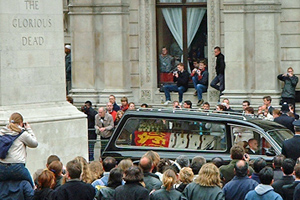 For those who like a bit of a knees up, there is the State Funeral. The last to be held in Britain was that of Queen Elizabeth The Queen Mother (pictured at right), and so precise was the planning that the dear lady even asked if she might supply the candlesticks to surround the catafalque as she wasn't all that keen on the ones provided by the Palace of Westminster. A State Funeral is very much a military affair, and every regiment for which the Queen Mother had been Colonel in Chief marched behind the gleaming gun carriage that bore her coffin. The plans for the Queen Mother's funeral (or "Tay Bridge" as they were codified) had been the foundation of the funeral for the late Diana, Princess of Wales, five years earlier. In the hysteria of the moment, the Government and the Royal Household thrashed out ways to make Diana's funeral less grand, and charity representatives rather than military delegations were asked to march behind the coffin. The Queen Mother's funeral was the genuine article, however. With her coffin draped in her Royal Standard and adorned with her crown, the last Empress of India was lamented to her glory by Scottish pipers. Thankfully, the crown stayed put, unlike the cross surmounting the Imperial State Crown at George V's funeral procession, which promptly rolled off and landed in the gutter. A frustrated Edward VIII was heard to declare, "Christ! Whatever next?" Tommy Lascelles suggested that it might have served as a motto for Edward's brief reign as King.
For those who like a bit of a knees up, there is the State Funeral. The last to be held in Britain was that of Queen Elizabeth The Queen Mother (pictured at right), and so precise was the planning that the dear lady even asked if she might supply the candlesticks to surround the catafalque as she wasn't all that keen on the ones provided by the Palace of Westminster. A State Funeral is very much a military affair, and every regiment for which the Queen Mother had been Colonel in Chief marched behind the gleaming gun carriage that bore her coffin. The plans for the Queen Mother's funeral (or "Tay Bridge" as they were codified) had been the foundation of the funeral for the late Diana, Princess of Wales, five years earlier. In the hysteria of the moment, the Government and the Royal Household thrashed out ways to make Diana's funeral less grand, and charity representatives rather than military delegations were asked to march behind the coffin. The Queen Mother's funeral was the genuine article, however. With her coffin draped in her Royal Standard and adorned with her crown, the last Empress of India was lamented to her glory by Scottish pipers. Thankfully, the crown stayed put, unlike the cross surmounting the Imperial State Crown at George V's funeral procession, which promptly rolled off and landed in the gutter. A frustrated Edward VIII was heard to declare, "Christ! Whatever next?" Tommy Lascelles suggested that it might have served as a motto for Edward's brief reign as King.
Of course there are always royals present, but one country in particular seems to have a way with funerals. The Dutch know how to send their royals off in style and the mourners wear white, a stunning contrast to the majestic beast of a hearse that trundles through the streets with its plumes, horses, and purple velvet. It's a far cry from the departure of the Chinese Emperors. In the last moments of their life, they had a solemn duty to proclaim their successor. Once they'd breathed their last, a very rare and expensive black pearl - sourced years in advance - would be placed in their mouths and their face covered by a white cloth before Tibetan monks flooded the room blowing trumpets and sounding drums to keep the spirit awake as it travelled to its new home. Such a ritual was denied to poor George II, who died on the lavatory. Bottoms up indeed.
So what if you were pondering exiting in the style of an Emperor or of a Queen? Well, firstly you must ensure that you've got some kind of bling to display alongside the coffin. A coffin isn't merely a box, it's a display case. For those who are too beautiful to have the lid closed, there is the option of embalming with a viewing. When you do finally allow your flunkies to nail down the top, it must be set off with any medals and orders you may have picked up in your lifetime, a Royal Standard of some description, and a crown for good measure. The coffin must be carried to at least two different locations before it goes groundward, and it must be hauled about on the shoulders of dashing soldiers in scarlet tunics. Your relatives must wear ridiculous hats and march behind you, and the Abbey or Cathedral that has the pleasure of hosting your last rites in this earthly abode should be suitably decorated. No "Mum" or "Lizzie" floral tributes here please. And once you've got the lengthy business of bells and smells out of the way, you can sleep safe in the knowledge that the world shall remember you, helped by the bloody big monument you designed for yourself decades previously, proving that whatever lies on the other side, royalty shall always have the upper hand.
Cemeteries and Mausoleums
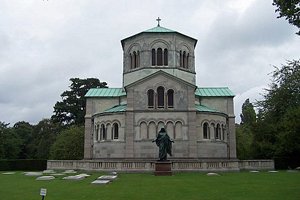 Royalty is quite cliquey, and this doesn't end when they're dead. Royals tend to be buried with their kith and kin, and nowhere is this more true than the Royal Burial Ground at Frogmore (pictured at left). From the Connaughts to the Gloucesters to the Windsors, the cemetery there is filled with the finest of the 20th century. The Duke of Windsor had originally intended that he and the Duchess would be interred in her home town of Baltimore in the United States, but during a visit to Windsor he decided on Frogmore as their final resting place and asked the Queen's permission for them to have their funeral services at St George's Chapel and to be buried at Frogmore. This permission was eventually (although, it is said, reluctantly) forthcoming, and the Duke and Duchess now lie side by side at Frogmore. Just a wander down the track from the Royal Burial Ground leads one to the spectacular mausoleum of Queen Victoria's mother, the Duchess of Kent. This vast edifice is a staggeringly imposing complex designed by A. J. Humbert; when built, it was intended to be used as a summer house as well as tomb, a typical display of the Victorian preoccupation with death. It is rivalled only by the mausoleum of Queen Victoria herself. Queen Victoria couldn't wait to die so that she would be reunited with Prince Albert, and she had her effigy (sculpted in the finest Aberdeen granite) made at the same time as her husband's, to be kept in storage whilst she prepared other plans for making their mausoleum fit for a Queen.
Royalty is quite cliquey, and this doesn't end when they're dead. Royals tend to be buried with their kith and kin, and nowhere is this more true than the Royal Burial Ground at Frogmore (pictured at left). From the Connaughts to the Gloucesters to the Windsors, the cemetery there is filled with the finest of the 20th century. The Duke of Windsor had originally intended that he and the Duchess would be interred in her home town of Baltimore in the United States, but during a visit to Windsor he decided on Frogmore as their final resting place and asked the Queen's permission for them to have their funeral services at St George's Chapel and to be buried at Frogmore. This permission was eventually (although, it is said, reluctantly) forthcoming, and the Duke and Duchess now lie side by side at Frogmore. Just a wander down the track from the Royal Burial Ground leads one to the spectacular mausoleum of Queen Victoria's mother, the Duchess of Kent. This vast edifice is a staggeringly imposing complex designed by A. J. Humbert; when built, it was intended to be used as a summer house as well as tomb, a typical display of the Victorian preoccupation with death. It is rivalled only by the mausoleum of Queen Victoria herself. Queen Victoria couldn't wait to die so that she would be reunited with Prince Albert, and she had her effigy (sculpted in the finest Aberdeen granite) made at the same time as her husband's, to be kept in storage whilst she prepared other plans for making their mausoleum fit for a Queen.
As well as taking laborious care over their final resting places, the Victorians adorned themselves with reminders of the deceased. Brooches, pendants, and lockets were stuffed with hair, nails, photographs, ribbons and other accoutrements from the dearly departed. One of the most recent finds was a brooch inlaid with the teeth of a small child, which was auctioned at Sotheby's last May. A popular Victorian hobby was creating books of the dead. These were huge scrapbooks which, among other things, contained photos of embalmed relatives who had been seated and photographed. They served as a catalogue of morbidity which suited the Victorian palate for everything funereal. A visit to Highgate cemetery will confirm the Victorian influence on the ritual of interment. There, the Egyptian-style circles of tombs play host to the grandest in society. Further down the road is Golders Green Crematorium, which has hosted a few royal guests in its time. Princess Louise, Duchess of Argyll, one of Queen Victoria's daughters, was cremated at Golders Green and her ashes interred at Frogmore, whilst King Prajdahipok of Siam was cremated and flown over to Siam to rest in the Chakri Throne Hall in the Grand Palace of Bangkok. In Surrey, an unusual royal is constantly venerated by Russian Orthodox monks at their monastery in the heart of Brookwood Cemetery. King Edward the Martyr was killed in 978 by his stepmother and thrown into the moat by an accomplice; his remains were secretly removed and placed into a special wooden casket. Today, the casket lies next to an icon of the Romanov Family and is venerated by the congregation regularly.
Speaking of Romanovs, no final resting place could be more grand than the St Peter and Paul Cathedral in St Petersburg. From Pierre le Grand to St Nicholas the Royal Martyr and Passion Bearer, the Tsars rest in opulent splendour, their most recent companion being the Dowager Empress Marie Feodorovna, who had to wait 78 years to join her husband Alexander III, thanks to a bloody revolution that sealed off Eastern Europe for most of the 20th century. Until her final journey to Russia in 2006, she had rested in the royal burial site in her native Denmark, Roskilde, which is home to such recent favourites as Queen Ingrid, born a Princess of Sweden.
In Memoriam
It's perhaps hypocritical, but from Boudicca to Grace Kelly, those born or raised to the purple will always see tears from devoted subjects, just as come revolution, civil war or assassination there'll always be one man who calls another man his King. Dandies and the pious both get the half-masted flags, the tributes from politicians and the horse drawn carriage - and really, whether the history books record you as a fabulous addition to cultural affairs or an overspending time-waster, you can be safe in the knowledge that you've lived life to the full. When you're royalty, you really have no other option.
Photo Credits
All photos on page 1: public domain.
Photo of Queen Victoria's funeral: public domain.
Photo of the Queen Mother's hearse taken by Flickr member AJK Photography and used with permission.
Photo of the Royal Burial Ground at Frogmore taken by Flickr member garyshield and used with permission.